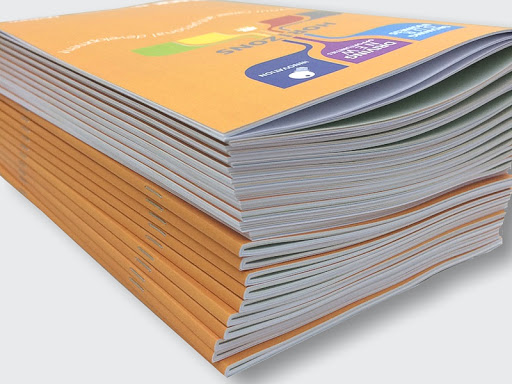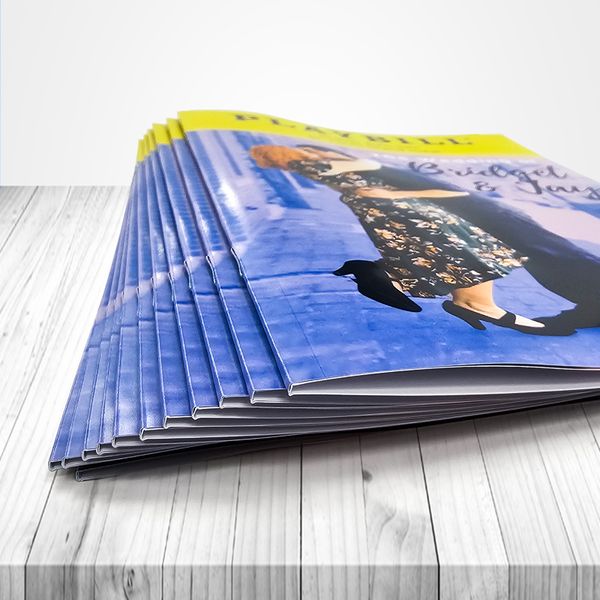10 Innovative Ways Booklet Printing Is Revolutionizing Promotional Campaigns
10 Innovative Ways Booklet Printing Is Revolutionizing Promotional Campaigns
Blog Article
The Vital Guide to Comprehending Booklet Printing Options and Techniques
The procedure of brochure printing entails several factors to consider that can substantially affect the end product. From choosing the proper format and size to comprehending the subtleties of binding methods, each selection plays a crucial role. In addition, variables such as paper stock and printing strategies more influence the efficiency of the booklet. As one navigates these options, it becomes crucial to realize how they adjoin and what that suggests for the general end result.
Recognizing Booklet Formats and Sizes
When thinking about booklet printing, recognizing the different layouts and sizes available is crucial for accomplishing the desired discussion. Pamphlets can be generated in various formats, including saddle-stitched, spiral-bound, and perfect-bound, each offering distinct advantages. Typical dimensions range from basic letter (8.5 x 11 inches) to smaller sized choices like A5 (5.8 x 8.3 inches), permitting adaptability based upon web content and target audience.Selecting the proper dimension can influence both the layout and reader engagement. Larger sizes could suit aesthetically driven web content, while smaller sized formats may be more straightforward and portable. Additionally, the number of web pages affects the choice of binding method, as thicker brochures may call for sturdier bindings. Eventually, understanding these aspects permits an extra tailored strategy, guaranteeing that the end product aligns with the desired message and aesthetic, improving the total effectiveness of the communication.
Selecting the Right Paper Supply

Binding Approaches: Choices and Factors To Consider
When it involves binding approaches for brochures, a number of choices are available, each with unique benefits. Saddle stitch binding offers a cost-effective solution for thinner booklets, while excellent binding strategies give an even more refined search for thicker magazines. Wire-O binding sticks out for its longevity and convenience of use, making it excellent for files that require flexibility.
Saddle Stitch Binding
Saddle stitch binding uses a cost-effective and useful solution for setting up booklets, making it a preferred selection amongst publishers and services. This binding method involves folding sheets of paper in fifty percent and stapling them along the fold line, creating a orderly and neat appearance. Normally ideal for booklets with a lower page matter, saddle sewing is suitable for publications, brochures, and instructional products. The simplicity of this technique enables quick manufacturing and is typically preferred for advertising things or short runs. However, it is vital to keep in mind that saddle stitch binding might not be appropriate for thicker booklets, as the spine may not stand up under enhanced weight. In general, it continues to be a trustworthy option for lots of printing tasks.
Perfect Binding Strategies
Perfect binding is a commonly made use of technique that supplies a refined and expert coating to brochures and publications. This approach involves gluing the pages together at the spine using a solid adhesive, enabling for a clean edge and the capability to hold a bigger variety of web pages contrasted to saddle sewing. Perfect binding is especially suitable for thicker booklets, such as directories and annual records, where a durable, level spinal column is desired. Additionally, it uses the alternative for a printed cover that can be developed to enhance visual allure. Considerations such as page matter, paper weight, and the planned use of the booklet ought to be taken into account, as they can affect toughness and overall high quality.
Wire-O Binding Choices
Wire-O binding, recognized for its longevity and adaptability, uses an excellent choice for booklets that require simple page turning and a professional look. This binding approach uses a series of metal loopholes that hold pages firmly, enabling them to lie flat when open. It is particularly suitable for presentations, magazines, and manuals due to its durable nature. Wire-O binding is available in numerous shades and sizes, fitting various web page matters and thicknesses. Additionally, it permits the incorporation of tabs and covers, improving the brochure's general visual. Factors to consider for Wire-O binding consist of the option of cable color, the dimension of the loops, and the level of modification preferred, every one of which can exceptionally influence the last product's appearance and functionality.
Digital vs. Offset Printing: Which Is Best for You?
When choosing a printing technique for pamphlets, recognizing the differences in between digital and balance out printing is crucial. Digital printing utilizes modern innovation to create top quality prints quickly and affordably, making it excellent for brief runs or tasks needing fast turnaround times. It permits modification, giving the ability to print on-demand with marginal waste.In comparison, counter printing is a standard method that stands out in creating large amounts with regular top quality. It involves moving ink from a plate to a rubber covering, then to the paper, which leads to vibrant shades and exact details. Counter printing normally requires longer configuration times and is more affordable for larger volumes.Ultimately, the option in between electronic and counter printing depends on task demands, budget plan, and preferred amount. For go to these guys little, time-sensitive tasks, electronic may be the very best selection, while offset might be more suitable for larger, high-quality manufacturings.

Designing Your Booklet: Tips and Best Practices
When designing a brochure, cautious focus to layout, font style option, and shade usage can considerably improve its effectiveness. A well-structured format guides the viewers's eye, while suitable typefaces ensure readability and convey the desired tone. In addition, efficient usage of shade can stimulate feelings and emphasize crucial information, making the total style extra impactful.
Selecting the Right Design
How can one successfully choose the ideal format for a booklet? It is vital to assess the pamphlet's objective and target audience. A clean, arranged layout improves readability and engagement. Utilizing a grid system can help in lining up elements continually, producing an expert look. Additionally, including aesthetic hierarchy through differing sizes and positionings of pictures and text can assist the reader's eye and emphasize crucial information. It is also vital to leave adequate white room, which stops congestion and permits much better emphasis. Ultimately, examining various layouts via mock-ups can supply understanding right into how the style does in real-world situations, making sure that the end product satisfies both practical and visual needs.
Picking Appropriate Fonts
An appropriate font can substantially improve the overall style of a brochure, matching the design and reinforcing the content's message. The selection of typefaces ought to consider readability, especially for body text, as it ensures the information is available to all readers. Sans-serif font styles are frequently chosen for digital formats, while serif font styles can lend a typical feel in published materials. It's advisable to restrict font choices to 2 or three to maintain aesthetic comprehensibility. Additionally, font dimension plays an important role; headings ought to be unique but not overwhelming, while body text must be comfy for reading. When selecting font styles, alignment with the booklet's style and target market is essential for effective communication and visual charm.
Efficient Use of Color
Shade functions as a powerful device in brochure layout, forming perceptions and assisting reader feelings. It can evoke sensations of trust fund, calmness, or excitement, relying on the colors have a peek at this site selected. Developers ought to consider color theory concepts, ensuring that the chosen palette lines up with the brochure's message and target audience. For circumstances, using cozy colors like red and orange can create necessity, while cooler tones like green and blue foster tranquility.Additionally, comparison plays an important function; corresponding colors can boost readability and aesthetic charm. Consistency in shade use across pages even more strengthens brand name identity and communication. Inevitably, reliable shade implementation not only records focus yet also reinforces the pamphlet's purpose, making it a necessary element of successful layout.
Finishing Touches: Coatings and Special Impacts
While numerous take into consideration the web content and format of a booklet the most essential elements, click resources the finishing touches, such as finishings and unique impacts, play a crucial duty in enhancing its overall charm. Coatings can supply defense and toughness, making certain that the pamphlet withstands damage. Matte finishes offer an advanced, non-reflective surface, while shiny layers can make shades appear more captivating and vivid. Special effects, like embossing or foil marking, add a tactile measurement that can develop an unforgettable perception. These techniques can highlight particular areas, accentuating vital info or producing aesthetic passion. Furthermore, UV covering can provide a high-shine surface that raises the total look.Together, these finishing touches not only boost the booklet's aesthetic yet also connect professionalism and trust and attention to detail, eventually leaving a long lasting influence on the visitor.
Cost Factors To Consider for Booklet Printing
Recognizing the various expense factors to consider for booklet printing is crucial for businesses and companies aiming to optimize their budgets. Secret factors influencing costs include the selection of ink, paper, and binding approaches. Higher high quality materials, such as exceptional paper or specialized inks, usually boost the general expense. In addition, the size and page count of the brochure play a significant duty; bigger booklets call for even more resources and time to produce.Another vital factor to consider is the printing technique, whether digital or offset, as each has its very own pricing framework and viability for different quantities. Businesses ought to also factor in design costs, which can vary based on intricacy and using expert solutions. Ultimately, shipping and handling costs can include to the total amount, particularly for big orders. By examining these components, organizations can make informed choices that straighten with their economic capacities while achieving the wanted quality in their printed materials.
Often Asked Questions
What Are the Environmental Effects of Booklet Printing?
The ecological effects of brochure printing consist of logging from paper production, carbon emissions from transportation, and waste generation from disposed of materials - Booklet Printing. Sustainable methods, such as utilizing recycled paper and environment-friendly inks, can minimize these effects
Exactly How Can I Ensure Shade Precision in My Pamphlet?
To ensure color accuracy in a booklet, one ought to make use of calibrated displays, use specialist color accounts, conduct examination prints, and pick high-quality printing solutions that supply shade matching and proofing choices for ideal results.
What Is the Regular Turnaround Time for Brochure Printing?
The typical turn-around time for booklet printing differs depending on the intricacy and quantity - Booklet Printing. Typically, it ranges from a couple of days to two weeks, affected by factors such as printing approaches and finishing demands
Exist Minimum Order Quantities for Brochure Printing?

Can I Publish Brochures in Several Languages?
Publishing pamphlets in numerous languages is feasible. Several printing services offer choices for multilingual or bilingual designs, allowing for efficient communication. Cautious preparation warranties that develop aspects suit various languages without endangering readability or appearances. In addition, aspects such as paper supply and printing strategies more affect the effectiveness of the pamphlet. When considering brochure printing, understanding the various formats and dimensions available is necessary for accomplishing the desired presentation. When choosing a printing approach for brochures, understanding the differences in between digital and offset printing is necessary. In addition, the dimension and page count of the pamphlet play a substantial duty; bigger booklets need even more sources and time to produce.Another crucial factor to consider is the printing technique, whether electronic or offset, as each has its own pricing structure and viability for different quantities. The ecological impacts of pamphlet printing include logging from paper production, carbon discharges from transportation, and waste generation from discarded materials.
Report this page